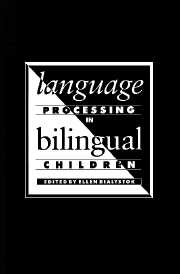Book contents
- Frontmatter
- Contents
- List of figures
- List of tables
- List of contributors
- Preface
- Introduction
- 1 Language modules and bilingual processing
- 2 Phonological processing in two languages
- 3 Second-language learning in children: a model of language learning in social context
- 4 Interdependence of first- and second-language proficiency in bilingual children
- 5 Giving formal definitions: a linguistic or metalinguistic skill?
- 6 Metalinguistic dimensions of bilingual language proficiency
- 7 Translation skill and metalinguistic awareness in bilinguals
- 8 Towards an explanatory model of the interaction between bilingualism and cognitive development
- 9 Constructive processes in bilingualism and their cognitive growth effects
- 10 Language, cognition, and education of bilingual children
- Index
5 - Giving formal definitions: a linguistic or metalinguistic skill?
Published online by Cambridge University Press: 11 January 2010
- Frontmatter
- Contents
- List of figures
- List of tables
- List of contributors
- Preface
- Introduction
- 1 Language modules and bilingual processing
- 2 Phonological processing in two languages
- 3 Second-language learning in children: a model of language learning in social context
- 4 Interdependence of first- and second-language proficiency in bilingual children
- 5 Giving formal definitions: a linguistic or metalinguistic skill?
- 6 Metalinguistic dimensions of bilingual language proficiency
- 7 Translation skill and metalinguistic awareness in bilinguals
- 8 Towards an explanatory model of the interaction between bilingualism and cognitive development
- 9 Constructive processes in bilingualism and their cognitive growth effects
- 10 Language, cognition, and education of bilingual children
- Index
Summary
As children go farther and farther in school, they are required to devote relatively more and more attention to the form as compared to the content of their language productions. Tasks which might seem straightforwardly communicative and linguistic, such as writing paragraphs, telling stories, answering comprehension questions, and explaining how things work, must increasingly also be dealt with as metalinguistic problems as form becomes a codeterminant of success along with content. One such task, which we will argue shifts from being linguistic to metalinguistic in the course of the elementary grades, is defining words. Young children very reasonably respond to a question like “What's a hat?” with “You wear it,” and such a response is tolerated if the child is young enough. Older children, on the other hand, are expected to respond to such questions by giving “formal definitions,” which conform to particular standards for form as well as for content, for example, “A hat is an article of clothing worn on the head.”
Definitions, though a rather specialized speech genre, are of both theoretical and practical interest to students of language development. In school settings, definitions are often requested of children, and giving definitions (or having children look them up in dictionaries and copy them) is a standard and frequent technique for vocabulary training.
- Type
- Chapter
- Information
- Language Processing in Bilingual Children , pp. 90 - 112Publisher: Cambridge University PressPrint publication year: 1991
- 41
- Cited by



